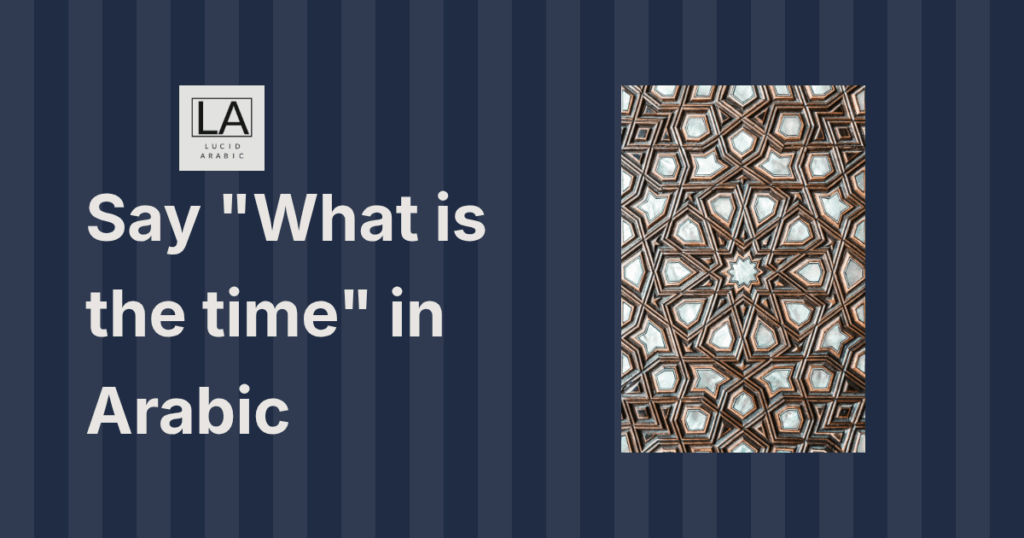Master Everyday Arabic: Learn How to Say “What’s the Time?” with Confidence and Ease
Time connects people — from meeting a friend for coffee to catching a flight, asking for the time is one of the most practical and polite phrases you can learn in any language. In Arabic, this simple question opens doors to interaction, understanding, and connection. Let’s explore how to say “What’s the time?” in Arabic, its pronunciation, cultural nuances, and fun facts to help you sound natural and confident.
🕒 The Arabic Phrase for “What’s the Time?”
The standard Arabic way to say “What’s the time?” is:
كَمِ السَّاعَةُ؟
kam as-sā‘atu?
Let’s break it down:
- كَم (kam) means “how much” or “how many.”
- السَّاعَة (as-sā‘ah) means “the hour” or “the clock.”
So, literally, كَمِ السَّاعَةُ؟ means “How much is the hour?”
Pronunciation guide: /kam as-saa‘a-tu/
You’ll notice that Arabs pronounce the س with emphasis because of the definite article ال (“the”).
🌍 Variations Across Arabic Dialects
Arabic dialects are wonderfully diverse, and the phrase “What’s the time?” sounds slightly different depending on where you are. Here are a few variations from around the Arab world:
- Egyptian Arabic:
السَّاعَة كَام؟
issā‘a kām?
(Literally “The hour is how much?”) — This is one of the easiest and most common versions you’ll hear in Egypt. - Levantine Arabic (Lebanon, Syria, Jordan, Palestine):
قَدّيشِ السَّاعَة؟
addeish is-sā‘a?
“How much is the time?” – This is a friendly, casual way of asking among friends or strangers alike. - Gulf Arabic (Saudi Arabia, UAE, Kuwait, Qatar):
كَم السَّاعَة الحِين؟
kam as-sā‘a al-ḥīn?
Adding الحِين (al-ḥīn) meaning “now” makes it more natural in Gulf speech — “What time is it now?”
Each version reflects regional charm and rhythm, giving you flexibility depending on where you travel or whom you speak with.
🗣 Usage Context and Examples
This phrase is handy in countless situations. Here are a few real-life examples:
- عَفْوًا، كَمِ السَّاعَةُ؟
‘afwan, kam as-sā‘atu?
→ “Excuse me, what’s the time?” - السَّاعَةُ الثَّالِثَةُ.
as-sā‘atu ath-thālithah.
→ “It’s three o’clock.” - كَم السَّاعَةُ الآن؟
kam as-sā‘atu al-ān?
→ “What time is it now?” - السَّاعَةُ وَاحِدَةٌ وَنِصْف.
as-sā‘atu wāḥidatun wa-niṣf.
→ “It’s one thirty.” - قَدّيشِ السَّاعَة هَلّأ؟ (Levantine)
addeish is-sā‘a halla’?
→ “What time is it now?”
Asking about time is not just functional—it’s often an icebreaker. In Arab countries, it’s common for people to start small talk by asking for the time, especially in markets, public transport, or waiting areas.
🌟 A Fun Fact About the Word
The Arabic word السَّاعَة (as-sā‘ah) has a deeper meaning than just “clock” or “hour.” It also means “moment” or “appointed time.” In Islamic tradition, السَّاعَة can refer to “The Hour” — the Day of Judgment, giving it profound spiritual significance.
So, when you say كَمِ السَّاعَةُ؟, you’re using a word that carries both everyday and eternal meaning.
📚 Origin and Cultural Connection
Historically, Arabs have had a strong relationship with timekeeping. Early Islamic civilizations were pioneers in developing astrolabes, sundials, and water clocks. Accurate time was essential for daily prayers (ṣalāh), which follow specific sun positions.
The expression كَمِ السَّاعَةُ؟ carries a cultural sense of mindfulness and respect for time — not just as a number but as a rhythm for daily life.
Furthermore, the Islamic principle of “Muslim Aid” — helping others — often manifests in daily courtesy. When you ask كَمِ السَّاعَةُ؟, it’s not uncommon for someone to respond warmly, even striking up a friendly chat afterward. Simple acts like these nurture the spirit of kindness embedded in Arabic culture.
💡 Practice Tip: Learn Time by Daily Observation
To get comfortable with Arabic time expressions, here are a few easy practice ideas:
- Use your phone in Arabic. Set your phone’s language to Arabic and observe how times appear (e.g., الساعة الرابعة = four o’clock).
- Ask a partner daily. Practice saying كَمِ السَّاعَةُ؟ or السَّاعَة كَام؟ each morning or evening.
- Listen for it in Arabic media. Watch news intros or series where time is mentioned. You’ll quickly catch pronunciation patterns.
Example sentences for extra practice:
- السَّاعَةُ التَّاسِعَةُ صَبَاحًا.
as-sā‘atu at-tāsi‘atu ṣabāḥan.
→ “It’s nine in the morning.” - السَّاعَةُ الثَّانِيَةُ بَعْدَ الظُّهْرِ.
as-sā‘atu ath-thāniyah ba‘da aẓ-ẓuhr.
→ “It’s two in the afternoon.” - السَّاعَةُ السَّابِعَةُ مَسَاءً.
as-sā‘atu as-sābi‘ah masā’an.
→ “It’s seven in the evening.”
🕰 Fun Cultural Insight
In Arab countries, especially in the Middle East and North Africa, time is viewed with flexibility and humanity. Being slightly late is often tolerated and jokingly referred to as “Arab time.” While it’s polite to be punctual, the warmth of relationships often takes precedence over the strict ticking of the clock.
So next time you ask كَمِ السَّاعَةُ؟, remember — it’s more than checking the hour. It’s a reminder that in Arabic culture, time flows through connection, not just precision.
💬 Final Thoughts: Time, Language, and Connection
Learning to say “What’s the time?” in Arabic might seem small, but it’s one of those essential phrases that reflects curiosity, respect, and cultural awareness. Whether you’re in Cairo, Beirut, or Riyadh, asking كَمِ السَّاعَةُ؟ bridges understanding and creates connection.
So, next time you check your watch, remember — every question opens a door to friendship and learning.

